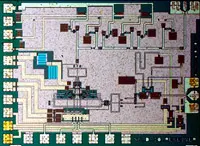Electronics News
Archive : 21 October 2014 год
 Weighing in at just 0.3g and measuring only 7 x 7 x 2.2mm, the FXTH87 tyre pressure monitoring system from Freescale is claimed to be 50% smaller than similar products on the market.
Weighing in at just 0.3g and measuring only 7 x 7 x 2.2mm, the FXTH87 tyre pressure monitoring system from Freescale is claimed to be 50% smaller than similar products on the market.
The TPMS system in package solution offers low power consumption and comes with a dual-axis accelerometer architecture, pressure and temperature sensor, integrated MCU, RF transmitter and low frequency receiver.
"We have a long history of innovation and success in pressure systems and in the automotive market, and we're leveraging that history to bring this tiny, integrated, low power system solution to our automotive customers," said Babak Taheri, vice president and general manager for Freescale's sensors solutions division.
The FXTH87 family is said to provide the industry's lowest RF power consumption at 7mA. Both the single and dual axis accelerometer options improve accuracy and facilitate more precise tyre localisation implementation and universal interoperability.
In addition, Freescale says the integrated MCU and dedicated firmware offer the largest customer flash memory at 8kbyte, increasing application flexibility and reducing time to market.
Author
Laura Hopperton
Source: www.newelectronics.co.uk
 A new microwave circuit developed at Chalmers University of Technology in Sweden may enable smaller antennas and faster video transmission.
A new microwave circuit developed at Chalmers University of Technology in Sweden may enable smaller antennas and faster video transmission.
Its suggestion is to use higher frequencies than today – upwards of 100GHz – that would give access to a larger band of empty frequencies, enabling a higher data rate.
"We have designed circuits for signals at 140GHz, where we have a large bandwidth," said Herbert Zirath, a professor in high speed electronics at Chalmers. "In laboratory testing, we have achieved a transmission rate of 40Gbit/s – twice as fast as the previous world record at a comparable frequency."
Prof Zirath says that semiconductor materials development, including indium phosphide, has enabled manufacture of circuits that can transmit high frequency signals with sufficiently high power.
"This is a very exciting area to be involved in, since the heavily increasing amount of data demands new solutions all the time. The fact that an increasing number of people are watching films wirelessly is the primary reason underlying the need for quicker transmission today."
The next step for the project is to move trials from the laboratory to the outdoors to test the circuits under real circumstances, with the goal of demonstrating wireless data transfer 100Gbit/s. "I believe it is only a matter of a couple of years before our circuits will be used in practical applications," Prof Zirath added.
Author
Graham Pitcher
Source: www.newelectronics.co.uk
